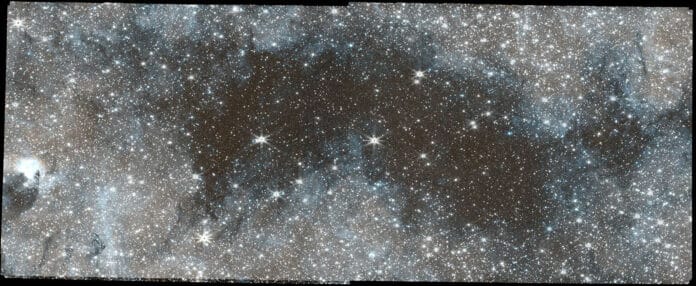Scientists are curious about a place called “The Brick” in our galaxies. It’s unique because it has a lot of dense gas that should make new stars, but it makes fewer stars than scientists thought. This has puzzled scientists for a long time.
The researchers used a powerful telescope called JWST to look into The Brick. They found much more frozen carbon monoxide (CO) there than expected. This discovery is important because it changes how we understand the process of making new stars in that region.
This study by University of Florida astronomer Adam Ginsburg shed light on a mysterious dark region at the center of the Milky Way. The turbulent gas cloud, playfully nicknamed “The Brick” due to its opacity, has sparked lively debates within the scientific community for years.
These discoveries reveal a puzzle at the center of our galaxy and show that we need to rethink our current ideas about how stars are born. It’s prompting scientists to reconsider their theories on star formation.
University of Florida astronomer Adam Ginsburg said, “With JWST, we’re opening new paths to measure molecules in the solid phase (ice), while previously we were limited to looking at gas. This new view gives us a more complete look at where molecules exist and how they are transported.”
In the past, scientists mainly studied CO gas using light emitted by it. Scientists needed strong light from stars and hot gas to understand how CO ice is spread in The Brick. This approach goes beyond the old way, focusing on only about a hundred stars. The new results cover more than ten thousand stars, offering valuable insights into the characteristics of interstellar ice.
The discovery is a big step in figuring out where the molecules in our Solar System come from. They were probably once ice on tiny dust grains that later formed planets and comets. These findings are just the beginning, as the researchers plan to explore more about celestial ices through further observations with JWST.
Ginsburg said, “We don’t know, for example, the relative amounts of CO, water, CO2, and complex molecules. With spectroscopy, we can measure those and get some sense of how chemistry progresses over time in these clouds.”
Journal Reference:
- Adam Ginsburg et al. CO absorption in the Galactic Center cloud G0.253+0.015. The Astrophysical Journal. DOI: 10.3847/1538-4357/acfc34
